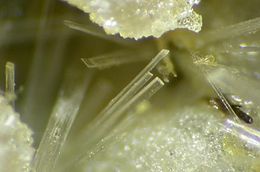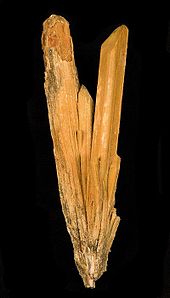Cervantite
Appearance
| Cervantite | |
|---|---|
 Microscopic cervantite crystals from Slovakia (3 mm field of view) | |
| General | |
| Category | Oxide mineral |
| Formula (repeating unit) | Sb3+Sb5+O4 |
| IMA symbol | Cvn[1] |
| Strunz classification | 4.DE.30 |
| Crystal system | Orthorhombic |
| Crystal class | Pyramidal (mm2) (same H-M symbol) |
| Space group | Pbn21 |
| Unit cell | a = 5.43 Å, b = 4.81 Å, c = 11.76 Å; Z = 4 |
| Identification | |
| Color | Yellow to nearly white |
| Crystal habit | Microscopic acicular crystals; massive |
| Cleavage | Excellent on {001}, distinct on {100} |
| Fracture | Conchoidal |
| Mohs scale hardness | 4–5 |
| Luster | Greasy, pearly, earthy |
| Streak | Pale yellow to white |
| Diaphaneity | Semitransparent |
| Specific gravity | 6.5 |
| Optical properties | Biaxial |
| Refractive index | nα = 2.000 nγ = 2.100 |
| Birefringence | δ = 0.100 |
| Dispersion | relatively weak |
| References | [2][3][4][5] |
Cervantite, also formerly known as antimony ochre[6]: 188 — is an antimony oxide mineral with formula Sb3+Sb5+O4 (antimony tetroxide).
It was first described in 1850 for an occurrence in Cervantes, Galicia, Spain, and named for the locality.[4] The mineral was questioned and disapproved, but re-approved and verified in 1962 based on material from the Zajaca-Stolice district, Brasina, Serbia.[3] It occurs as a secondary alteration product of antimony bearing minerals, mainly stibnite.[3]

References
[edit]- ^ Warr, L.N. (2021). "IMA–CNMNC approved mineral symbols". Mineralogical Magazine. 85 (3): 291–320. Bibcode:2021MinM...85..291W. doi:10.1180/mgm.2021.43. S2CID 235729616.
- ^ Mineralienatlas
- ^ a b c Handbook of Mineralogy
- ^ a b Mindat.org
- ^ Webmineral data
- ^ James Dwight Dana A. M., Brush G. J. A system of mineralogy : Descriptive mineralogy, comprising the most recent discoveries. — New York : J. Wiley & Sons, 1884.
